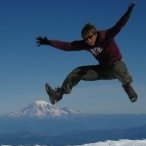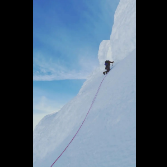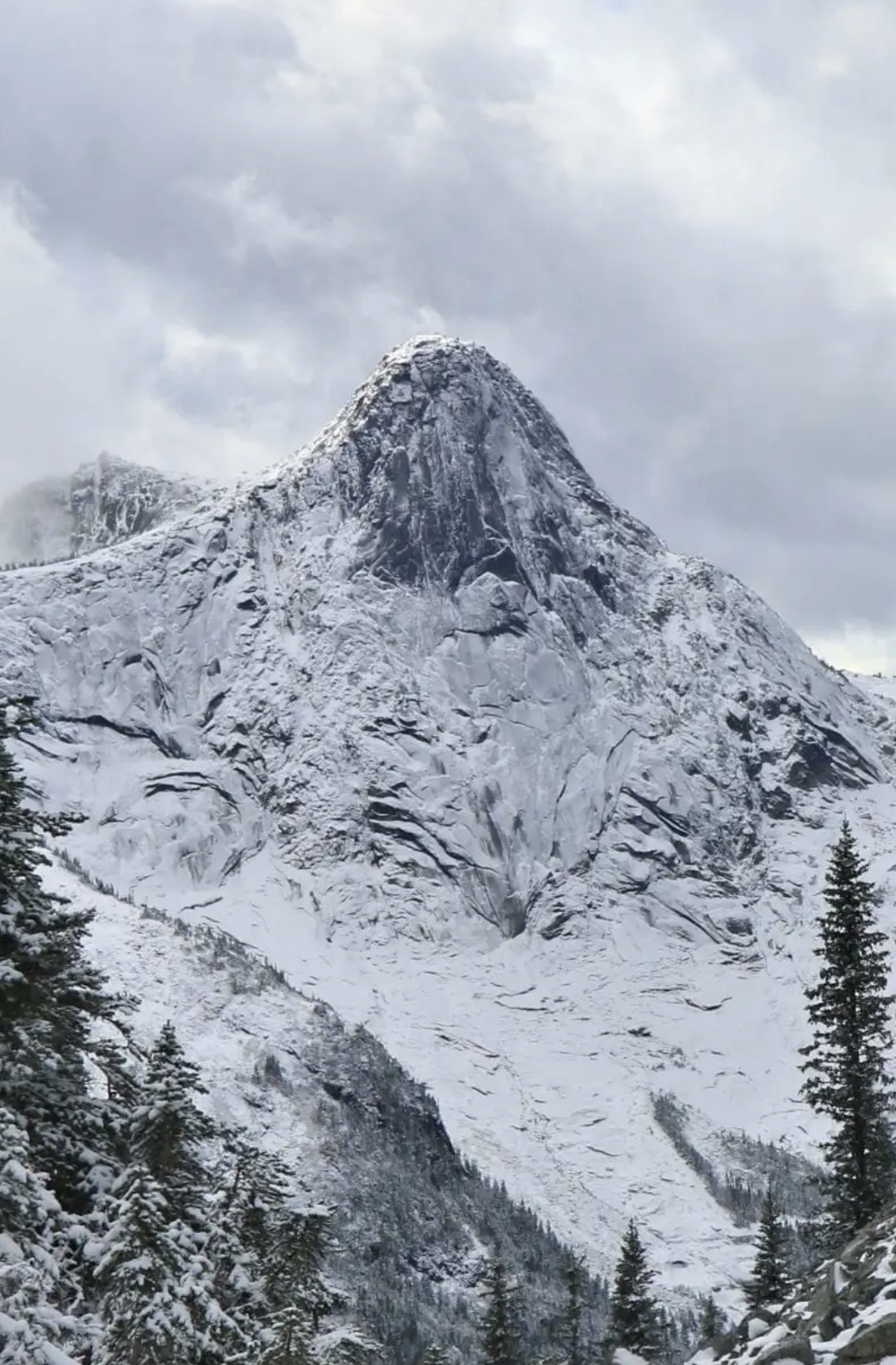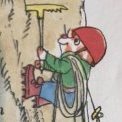Leaderboard
Popular Content
Showing content with the highest reputation on 03/13/24 in all areas
-
Trip: Argonaut Peak - East Ridge/NE Couloir Trip Date: 03/09/2024 Trip Report: Argonaut Peak (8,455 ft) March 9, 2024 East Ridge/NE Couloir 18 miles skiing/climbing, 10 miles snowmobiling, 8300ft gain 73/100 Winter Bulgers Eric and Nick On the summit The weekend looked to be stormy but the Enchantments zone seemed to be getting hit the latest. I’d previously bagged all the Bulgers peaks in the Enchantments in winter except Argonaut, so we decided to go for it. The route I’ve previously climbed Argonaut twice via the south face route (May, August), which ascends a steep gully to the summit ridge followed by a class 3/4 scramble to the summit. This is not necessarily the best winter route, though. In February 2022 Nick and I had been camped near the base after climbing Sherpa and planned to climb the south face route, but my updated NWAC forecast on my inreach made us too nervous about snow stability. So we bailed that time. Our East Ridge/NE Couloir route (drawn on picture taken by John Scurlock from the north) This weekend the snow stability conditions didn’t look great for that route either. But Argonaut has many different route options, generally all technical. I noticed we could ascend gentle slopes up the Porcupine Creek drainage on the south side to gain the Argonaut-Colchuck col at 7700ft keeping the slope angle low. From there we could climb one of the technical routes up to the summit. The routes might require crossing short snow slopes, but we would be roped up clipped in to gear in the rock so would be protected. We would bring a 60m half rope, hexes, nuts, cams, and technical tools. I would bring one technical tool with a hammer (for the hexes) and one ultra-light corsa straight shafted axe with a custom 3D-printed adjustable pinky rest Nick had just printed. This would allow me to plunge in snow and save some weight. We’d also each bring our custom carbon fiber ascent plates Nick had CNC milled. Unloading the sled The main route options from that col appeared to be the East Gully, the East Ridge, and the NE Couloir. Neither of us had done any of these routes but we figured we could see what looked the most reasonable based on conditions and climb that. The first record I could find of a winter ascent of Argonaut was via the NE Couloir (Lurie, Feb 2006, NWMJ). But climbing the full couloir seemed too risky with the snow conditions since it’s a ~3,000ft long snow gully and I wouldn’t want to be in the bottom if it slid. Worst case we would just cross the top of it, roped up, which would be much safer. At the Beverly Creek trailhead The shortest approach would be from the Beverly Creek trailhead, which is accesible by snowmobile. In order to beat the incoming storm we wanted to summit by noon, so that meant leaving very early. We decided to do a car-to-car push to avoid carrying overnight gear over the fourth creek pass. Friday evening we got to the Twentynine Pines staging area on Teanaway River road, unloaded the sled, and went to bed. Saturday we were up and moving by 12:30am. The road had just been groomed and we made excellent time, hitting 40mph in places. The Beverly Creek turnoff was a bit rougher, but we reached the trailhead 20 minutes after leaving the truck. Interestingly, there was a nice skin track already going up from the trailhead. This is very unusual for winter Bulgers trips. Crossing Bean Creek We followed the tracks across Bean Creek, but then they diverged west after a few miles. It looked like they might have been heading for Iron Peak. We then broke trail up to the Fourth Creek saddle, and transitioned to ski mode. We had fun turns going down fourth creek, then transitioned to skins as it flattened out. We skinned down to Ingalls Creek, trying to set a good track for our return trip. Ingalls Creek The creek was too high to rock hop across, but we found a nice fallen log across near the trail crossing. It was 8″ wide with a foot of snow on top and lots of branches sticking out. I strapped my skis on my back and started over au chaval. I karate chopped the icy snow off the top, then used an ice tool to bang off the branches. Progress was slow but this worked and made for a nice smooth crossing on the return journey. On the other side we skinned up to the Ingalls Creek trail, followed it east for a half mile, then left the trail heading up the Porcupine Creek drainage. The slopes were nice and mellow angle and the forest was mostly open for easy travel. As we got higher to more open areas the snow had a firm sun crust. We started on the west side, then crossed over to the east side and ascended into the large bowl flanked by Argonaut, Colchuck, and Dragontail. Conditions were pleasant with no wind and great views of the summits. We knew that would change by afternoon, though. Approaching Argonaut in the upper Porcupine Creek drainage We noticed the East Gully route looked like it might go, though was kind of steep. We decided to head to the Argonaut-Colchuck col to scope out the East Ridge and NE Couloir to see which one we preferreed. As we crested the ridge the wind picked up from the south, and we noticed the north side would be much more sheltered. It looked doable to ascend the East Ridge then cross over the top of the NE Couloir to gain the upper north face of Argonaut. That sounded appealing given the wind direction, so we went for that route. At the col We ditched skis at the col, then roped up. Nick started first and we shortened the rope to 30m and simul climbed. The East Ridge started getting steep soon so we dropped onto a snow ramp which we traversed across to enter the NE Couloir. We got good gear in the rock to protect a fall in case the snow slid. On the opposite side of the Couloir Nick built an anchor and we swapped leads. I kicked steps up the right side of the couloir for 30m then when the couloir dead ended at a rock face I exited up and right. Crossing into the NE Couloir This section was the crux of the route. The snow got thin and steep on a rock slab except for a thick wind deposit about 3ft deep. I had to tunnel through it Cerro-Torre-style, digging down to the thin icy layer on top of the slab to get good purchase with my front points. I kind of wished I had the custom wings on my ice tools. Eventually I excavated out an old rap anchor, clipped it, and tunneled the last bit up to the low-angle north face snowfield. In the upper NE Couloir I belayed Nick up there with a solid hex anchor and we swapped again. Nick led up the left side of the snowfield, getting a few gear placements in the rocks on the side. We eventually simul climbed up to the summit ridge, and swapped leads again. I traversed the ridge, weaving the rope around horns and getting a few intermediate pieces in. I had to make a few mixed climbing moves getting over one rock step. At last, I saw the famous tunnel under the summit boulder, and luckily it had a big enough gap to squeeze through. Nick on the summit By 1pm I made the final short mixed scramble to the summit. I belayed Nick up off the summit horn, and we were soon both on the summit. It was windy, but luckily not snowing yet. It appeared the storm was coming in a bit later than forecast, which was great news. There was no view in the whiteout, so we soon regrouped and headed down. I led the way back as we simul downclimbed the ridge and retraced our exact track back down the snowfield. We regrouped above the crux, and we decided to simul downclimb that as well. Now that the snow was excavated and good steps were kicked it wouldn’t be too hard. I put the exact same gear placements in as on the way up, and we simuled back down to our previous anchor point. There Nick took over and led back across the ramp to the Argonaut-Colchuck col by 2:30pm. Descending the summit ridge Now the storm had hit with full force, and it was extremely windy and snowy. I was jostled off balance a few times. Back at the skis we put goggles on, and decided to crampon down in the whiteout until it got more sheltered. I followed the track on my watch since our up tracks were drifted over. After 10 minutes we got back into intermittent trees and the wind died down. Unexpectedly, it then cleared out and was partly sunny! It appeared to be a brief break in the storm, and came at the perfect time. We switched to skis and had fun turns down the big open slope. Though, lower down we hit sun crust which made skiing challenging. Hiking down in the storm We switched back to crampons and descended down into denser trees. Back in the trees the sun crust disappeared and we again skied back down. The icy lower sections had changed to a small layer or corn and made for excellent skiing. We eventually reached the Ingalls Creek trail as the sun gave way to heavy graupel and snow. There we skinned back to Ingalls Creek and scooted back across the log. Last view of the south face of Argonaut We then followed our tracks back up fourth creek as darkness set in. At the pass we switched back to ski mode and made a high traverse back down the Beverly Creek drainage. Interestingly, we encountered a set of snowshoe tracks that had followed our tracks up to 5000ft. This appears to be a relatively popular area in winter! I guess the road approach is only five miles, so a snowmobile isn’t really necessary. Though I certainly appreciated being able to sled in and out instead of walk. Sledding out It was fun cruising down the drainage, and we made it back to the sled by 8:45pm. We then strapped our gear on and got back to the truck around 9:15pm for a 21-hour push. Gear Notes: Snowmobile, 60m rope, skis, technical tools, hexes, nuts, cams, ascent plates (unused but we probably should have used them) Approach Notes: Sled to Beverly Creek TH, ski to Argonaut-Colchuck col3 points
-
1 point
-
Is that what those are? I will keep a eye out for you on others that might work1 point
-
1 point
-
This is just flat out wrong and I want to point this out since @AlexC192 is listening, responding, and trying to learn from their intense climb. I don't take this lightly. I feel very strongly that this is bad advice. Especially in light of the raps these guys are making, off single pieces, in the dark, completely knackered. A simple map/aerial review of the Yak Peak area would have identified a probable walk-off a short distance away (and everyone in this day and age really should be looking at and carrying these information sources in their pockets). Getting to the top is only halfway, and figuring out your descent plan is just as important as figuring out your route up, maybe more so, since you are going to be tired and it will be late in the day. Do your research. Are there times when rapping the way you came is the best alternative? Sure. Are there times when it is a terrible idea? Absolutely. This was one of them. I am glad that @AlexC192 is open and honest with how far strung-out they were- we owe it to him to give good advice, tailored to his situation, and not some general platitudes.1 point
-
That is an Awesome looking line! Picture are beautiful. You and your buddy are mighty! You now have more experience than 99% of PNW climbers on technical alpine terrain in the winter.1 point
-
Great trip report, and thanks for writing it up in such an honest way! That's how you learn. We all did stupid stuff above our heads when we were younger, and those of us still posting made it out alive, but not everybody did. I advise you to do what I did. Take some of that money you are going to spend on new gear and invest it in getting some in-person instruction from a really well qualified guide. Get a little group together and the cost will be reasonable. or at least find an experienced ice climber who is also a good teacher, buy them a case of beer to take you out somewhere nearby and teach you as much as they can. Congrats on the probable FA. So I actually want to congratulate you on the decision to rap the route. I don't know the mountain or the descent options, but just going from the TR info, it appears you didn't also. so in my opinion, that was your best decision of the day and just might have saved your life. if you're not absolutely sure about alternative means of descent, it is ALWAYS better to go back the way you came. Well done. So many climbing accident reports begin with "they decided to seek an easier way down" or "they descended via _______, a route they were not familiar with." You can easily be cliffed out or find yourself in even more of an epic, and once hypothermia sets in, you start making stupid decisions without even realizing it. Others have commented on your rappel techniques. Trying to save 10 bucks by threading your rope through a wire made my shudder. You were lucky to survive that as well. You DO need to spend more time learning and PRACTICING rappelling in a safe environment. You can read great techniques in books but you need to dial that shit in at home before you try it in the field. (it's by far the most dangerous part of climbing as you probably know intellectually). If you haven't read through any of the "American climbing accidents" annuals, I highly recommend it. You can learn a lot from the mistakes others make, and it's a guaranteed injury-free activity, as well as being a pretty compelling read. One last complement- your willingness to keep learning is what will save you. Well done. Lots of people think they're invincible and aren't as self aware as you seem to be. It's great to see.1 point
-
I appreciate the concern and the gear advice from both of you. I will definitely admit, and tried to make that known that we could have and should have waited to do this. I bit off more than I could chew and definitely acknowledge that. After talking to @JasonGa bit more it appears that there is a good walk off with maybe a few steeper tree rappels off the sub peak between Yak and Nak. I will definitely be looking more into descent options on future routes and planning to stay on established ones for a bit longer. We did back up most of those raps with a screw or picket while I went down as to not blindly trust it but I definitely can acknowledge that this is not ideal and not what we should do everytime. Also been reading "Down" this past week. It has been a great read for me and seeing how we can do better on rappels like this. Also went back into Marc Andres blog and was reading about his solo of Mt Robson (don't worry no desire to solo. I infact do not want to die and appreciate a belay) and noticed how he was tired at the top so dug a pit and crawled in his bivy bag for a bit. That was good insight for me that if you need rest figure out how to get it before going back into the rough terrain and environment. I appreciate your guys feedback. Feedback from people that know a thing or two because they've done a thing or two is much appreciated and remembered when we're in situations trying to figure out what to do I remember words of wisdom from more experienced climbers than myself. I'll pick up a couple more peckers next time I'm at the climbing shop.1 point






